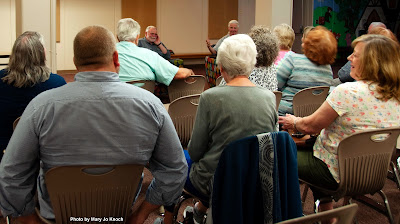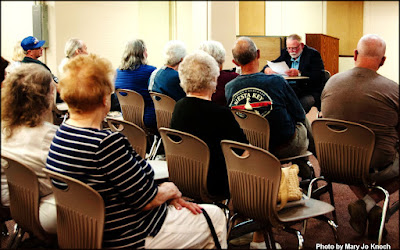 |
| Downtown Miami |
That said, on this
trip, I’m soloing. Saúl picked me up at the airport on my arrival in the US a
month ago, but while I was up in Ohio promoting my two books—The Rock Garden,
and Visions of What Used To Be—and visiting friends and family that the
pandemic had prevented me from seeing for several years, Saúl had a knee
operation. So now that I’m back in Miami, my friend is out of commission. He
had a Cuban friend of his—Jorge, who is also a professional driver—pick me up
at the airport, drive me to my hotel and take me to the business appointment I
had on Friday morning. But the relationship has been strictly professional
between Jorge and me. So I’ve been entertaining myself entirely on my own since
I returned from Ohio on my way back to Argentina.
 |
| My friend and guide to Miami, Saúl |
There was what I
thought was a bad surprise waiting for me when I got to my hotel. It was my first
time staying here—here being the Comfort Inn Downtown. My regular haunts were
the Hotel Urbano at Brickell and I-95 and the Hampton Inn a couple of blocks
off of Brickell on Twelfth, but the Urbano has become a Hilton Garden Suites
and the other one has also been upgraded and both have become quite pricey. So
I chose the Comfort Inn on the basis of price—which was slightly less
jaw-dropping than the other two. Anyway, on arrival, I was advised that, due to
some credit card snafu, the reservation I’d made two months earlier had been
canceled. Basically, I had no room.
I’d been traveling
since morning, from Cleveland to New York and from New York to Miami, and
hadn’t eaten anything all day but a couple of English muffins early in the
morning, and two Delta Airlines cookies in the afternoon, and it was now 8pm,
so I was in no mood for getting jerked around and I immediately lost my temper
and went ballistic on the poor desk clerk.
But dark clouds sometimes
have a silver lining. He politely invited me to calm down and told me he was
giving me a twelfth-floor suite for the same price as the room that they’d
canceled. When I told him I was hungry and asked where I could get a bite to
eat, he asked if I liked Peruvian food and sent me around the corner to a place
called La Granja, with cold beer, good food and even better prices.
 |
| A room with a view |
The hotel breakfast
room overlooks the river, and I watched while eating my initial breakfast there
as the first tour boats and container barges of the day made their way along
the river’s course to and from the Port of Miami. I would locate the port later,
when, following my Friday morning appointment, I took a stroll along the
boardwalk that runs behind the hotel as far as I could before running into a
construction site that blocked my path. From there, I could see in the distance
the towering cranes that marked the port.
 |
| Container barge passing by the breakfast room |
Since then, I have
whiled away more than a few hours walking back and forth past three major
bridges from one end to the other of my promenade, observing the traffic on the
Miami River. There are a couple of things that are extraordinary about it.
First of all, except for the rail bridge, which is so very, very tall that any boat
capable of fitting in the Miami can go under it, the others are draw bridges. I
found the entire process of their opening and closing—as powerful tugs ushered
through huge container barges, whose massive bulkheads nearly scraped the
bridge abutments—utterly fascinating. One of them (the one I could see clearly
from my twelfth-floor vantage point) is a four-lane structure and the operation
of it is really impressive to see. The other thing that grabbed my attention
was the incredible number of astronomically expensive yachts and cabin cruisers
that one can see while standing on the quayside for a mere half hour.
As an aside, I should
clarify that, for more than a decade, I was the chief (only) translator for a
Panamanian publication entitled Luxury Road—now defunct, thanks to the
2008 worldwide economic crisis and its aftermath in the luxury industry. It was
a lingering death, but fatal all the same.
When you scratch the
surface, Miami is a small town. In its downtown area—the older shops, city
government buildings, etc.—are provincial, almost poky in nature. The original
Miami, the “local” Miami, if you will, is nothing at all like the glittering
Miami that one sees in the movies. It’s no secret that much of the
extraordinarily stunning architecture of the more usually visible Miami that we
see in TV series, films and magazines mushroomed out of the drug trade of the
seventies, eighties and nineties.
 |
| Miami's glistening Brickell-Downtown |
But Miami law
enforcement and federal agents fought back and cracked down hard. Nowhere was
that fight better documented than in the TV series Miami Vice in the mid-nineteen-eighties. The show was not only well-researched
and wildly popular, but also introduced the salsa sound into mainstream music,
and the “Miami look” into male fashion (a sort of Latino-cool, mafia-casual
look) and into high-end interior décor.
That said, although
Miami has become a much tamer version of the earlier warring cocaine capital
that it had become, the wealth to which drug traffic first gave birth appears
not to have waned in the least. In fact, Miami is now the second least
affordable city (after New York) in the country. And it recently surpassed the
Big Apple as the city with the nation’s least affordable housing.
One of the places they
can go—apart from the city’s many bars, restaurants and nightclubs—is the new
downtown mall known as Brickell City Centre. No, it’s not naïve of me to think
that people who own those cars and those boats might entertain themselves in a
shopping mall. Because this is no ordinary mall. It has got to be one of the
highest-end shopping centers in the country.
 |
| Brickell City Centre |
 |
| The purse - "a steal" at $2.700! |
For me, the whole scene has a carnivalesque quality to it. No part of this world is a corner where I wouldn’t stand out as a total alien. It’s a place for easy money, not for money earned in a job where you get paid by the word. But there’s a sideshow quality to being able to wander for a while along the midway, observing the attractions to either side with no real thought of participating in what seems, essentially, to be a freak show—a place where the unusual and, indeed, the outrageous are on full display.
 |
| Back to reality... |
Clearly, it wouldn’t be hard at all, if I were so inclined, to blow my life savings in a day—or in an hour—in this place where I have no business being. But for me it’s been fun to venture for a spell into an environment that is completely beyond my means or comprehension, and to observe how the other two percent lives in that “other Miami”.
And now…back to
reality.
























